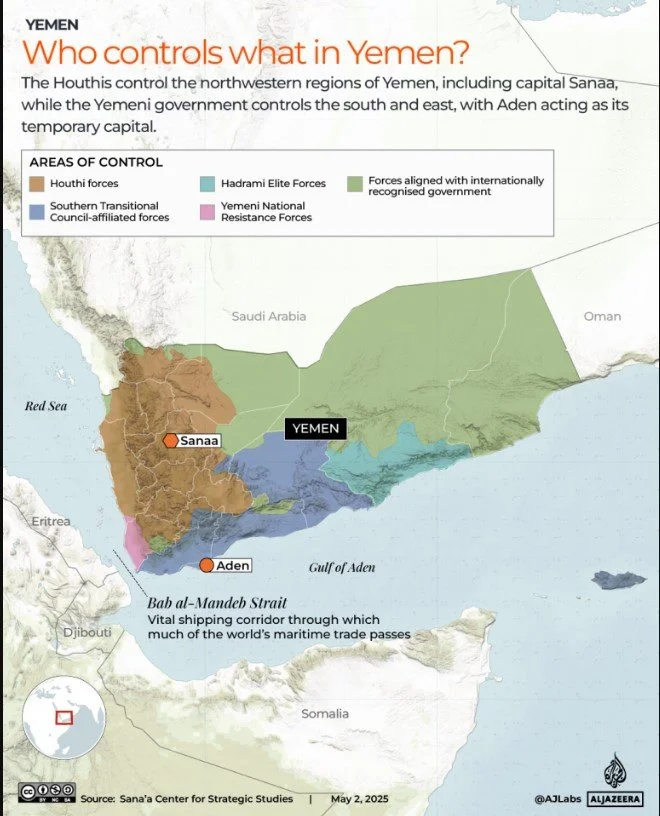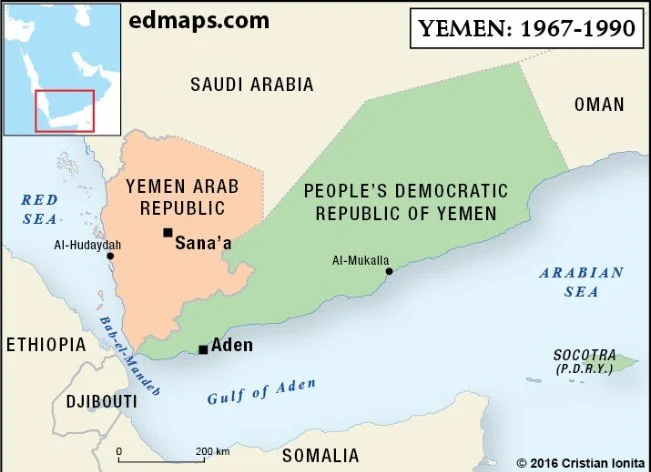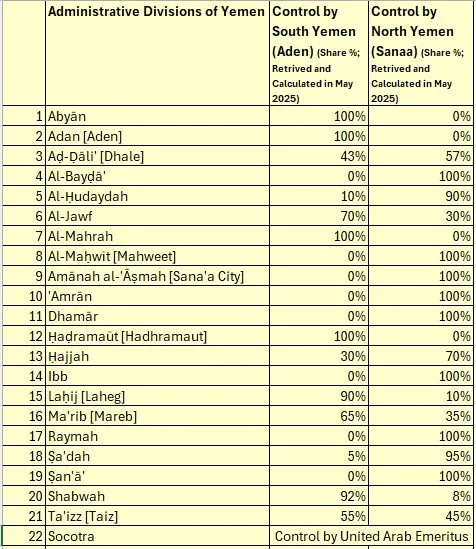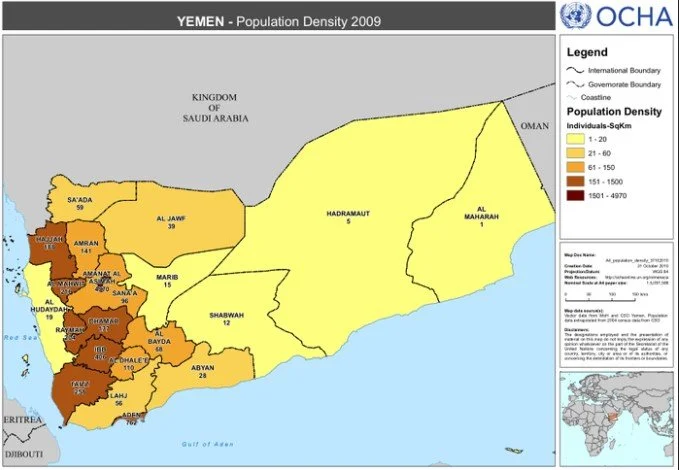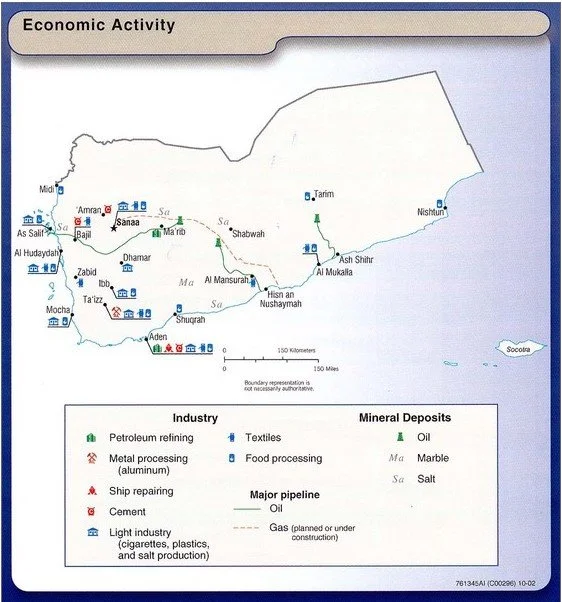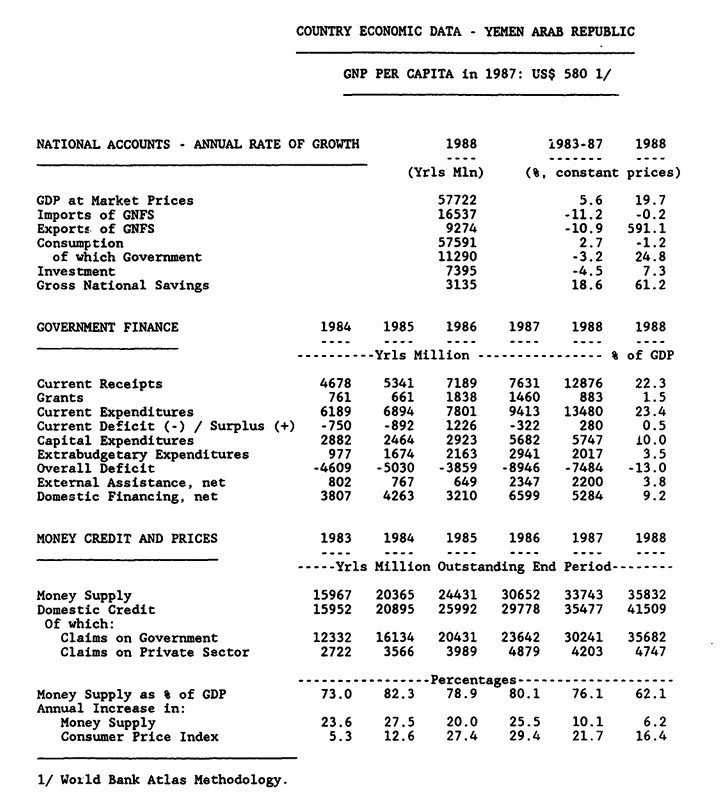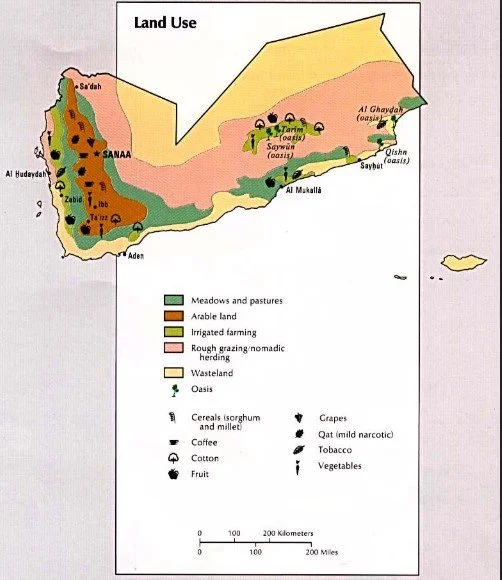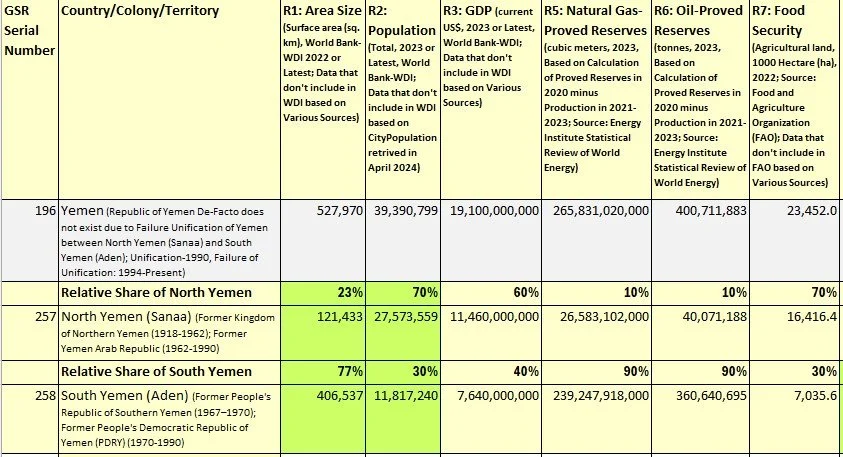Section H1. Appendix I: Yemen - North Yemen (Sanaa) and South Yemen (Aden), 2025 Global Survival Rank (GSR) by Dr. Ziva Rozen-Bakher
https://www.rozen-bakher.com/gsr/2025/h/yemen
Published Date: 12 October 2025
COPYRIGHT ©2022-2025 ZIVA ROZEN-BAKHER ALL RIGHTS RESERVED
Global Survival Rank (GSR) by Dr. Ziva Rozen-Bakher: Yearly Rank to Compare the Global Political Power among Countries, Alliances and Coalitions to Survive Long Wars at the Military, Economic, and Political Levels
Rozen-Bakher, Z. Global Survival Rank (GSR) by Dr. Ziva Rozen-Bakher https://www.rozen-bakher.com/gsr
Rozen-Bakher, Z. 2025 Global Survival Rank (GSR) by Dr. Ziva Rozen-Bakher, 2025 Global Survival Rank (GSR) by Dr. Ziva Rozen-Bakher, 12 October 2025, https://www.rozen-bakher.com/gsr/2025
Rozen-Bakher, Z. 2024 Global Survival Rank (GSR) by Dr. Ziva Rozen-Bakher, 2024 Global Survival Rank (GSR) by Dr. Ziva Rozen-Bakher, 30 April 2024, https://www.rozen-bakher.com/gsr/2024/e
Rozen-Bakher, Z. 2023 Global Survival Rank (GSR) by Dr. Ziva Rozen-Bakher, 2023 Global Survival Rank (GSR) by Dr. Ziva Rozen-Bakher, 29 April 2023, https://www.rozen-bakher.com/global-survival-rank-zrb/2023
Dr. Ziva Rozen-Bakher
Researcher in International Relations and Foreign Policy with a Focus on International Security alongside Military, Political and Economic Risks for Foreign Direct Investment (FDI) and International Trade
Section H1. Appendix I: Yemen - North Yemen (Sanaa) and South Yemen (Aden), 2025 Global Survival Rank (GSR) by Dr. Ziva Rozen-Bakher
Appendix’s Objectives
Objective I: Laying the reasoning for Why the country Yemen de-facto does not exist, and instead, there are two disputed countries: North Yemen (Sanaa) and South Yemen (Aden). That was accomplished by analysing the historical background of Yemen to determine the current geopolitical position of North Yemen (Sanaa) versus South Yemen (Aden). See Sections H1.1-H1.3
Objective II: Methodical Explanation for how the data on North Yemen (Sanaa) and South Yemen (Aden) in the 2025 Global Survival Rank (GSR) were processed. That was accomplished by presenting the processing of the data in four steps:
Step I: Revealing the areas in Yemen that are controlled by North Yemen (Sanaa) versus South Yemen (Aden) at the level of the Administrative Divisions of Yemen. See Section H1.4
Step II: Calculation or Evaluation of each Indicator (R1-R7) of Global Survival Rank (GSR) at the level of the Administrative Divisions of Yemen to reveal the relative share of North Yemen (Sanaa) versus South Yemen (Aden) in relation to each indicator. See Section H1.5
Step III: Calculation of Global Survival Rank Indicators (R1-R7) based on the Formal Data of Yemen in relation to the Relative Share of North Yemen (Sanaa) versus South Yemen (Aden). See Section H1.6
Step IV: Presenting the Global Survival Rank Indicators (R1-R7) in the 2025 Global Survival Rank (GSR) in relation to Yemen, North Yemen (Sanaa), and South Yemen (Aden). See Section H1.7
List of Contents
Section H1. Appendix I: Yemen - North Yemen (Sanaa) and South Yemen (Aden), 2025 Global Survival Rank (GSR) by Dr. Ziva Rozen-Bakher
Appendix’s Objectives
Section H1.1 Background about the Failure of Unification of North Yemen (Sanaa) and South Yemen (Aden)
Section H1.2 Timeline: Yemen, North Yemen (Sanaa) and South Yemen (Aden)
Section H1.2.1 Before the Unification of Yemen: North Yemen (Sanaa) (1918-1990) and South Yemen (Aden) (1838-1990)
Section H1.2.2 Unification of Yemen and Before the Start of the Yemeni Civil War: Establishment of the Republic of Yemen by Unification of North Yemen (Sanaa) and South Yemen (Aden), 1990-1994
Section H1.2.3 Failure of the Unification of Yemen due to the Yemeni Civil War between North Yemen (Sanaa) and South Yemen (Aden), 1994-Current
Section H1.3 Geopolitical Position in the 2025 Global Survival Rank (GSR): North Yemen (Sanaa) versus South Yemen (Aden)
Section H1.4 Control Over Areas in Yemen: North Yemen (Sanaa) versus South Yemen (Aden)
Section H1.5 Calculation or Evaluation of each Indicator (R1-R7) of Global Survival Rank (GSR) at the Level of Administrative Divisions of Yemen: North Yemen (Sanaa) versus South Yemen (Aden)
Section H1.5.1 Indicator R1 - Area Size: North Yemen (Sanaa) versus South Yemen (Aden)
Section H1.5.2 Indicator R2 - Population and Army Size: North Yemen (Sanaa) versus South Yemen (Aden)
Section H1.5.3 Indicator R3 - Domestic Economic Activity (GDP) and the Ability of Military Expenditure in Long Wars (25% of GDP): North Yemen (Sanaa) versus South Yemen (Aden)
Section H1.5.4 Indicator R4c for Disputed Countries - International Recognition: North Yemen (Sanaa) versus South Yemen (Aden)
Section H1.5.5 Indicator R5 - Energy Security: Gas-Proved Reserves: North Yemen (Sanaa) versus South Yemen (Aden)
Section H1.5.6 Indicator R6 - Energy Security: Oil-Proved Reserves: North Yemen (Sanaa) versus South Yemen (Aden)
Section H1.5.7 Indicator R7 - Food Security: North Yemen (Sanaa) versus South Yemen (Aden)
Section H1.6 Calculation of Global Survival Rank Indicators (R1-R7) based on the Formal Data of Yemen in relation to the Relative Share of North Yemen (Sanaa) versus South Yemen (Aden)
Section H1.7 Global Survival Rank Indicators (R1-R7) in the 2025 Global Survival Rank (GSR): Yemen, North Yemen (Sanaa), and South Yemen (Aden)
Section H1.1 Background about the Failure Unification of North Yemen (Sanaa) and South Yemen (Aden)
For More Information about Yemen, North Yemen (Sanaa) and South Yemen:
Yemen, Blog on FDI and International Trade by Dr. Ziva Rozen-Bakher, 31 May 2021, Cycle I, https://www.rozen-bakher.com/blog/2021/05/31/yemen
South Yemen (Aden), Blog on FDI and International Trade by Dr. Ziva Rozen-Bakher, 09 April 2025, Cycle I, https://www.rozen-bakher.com/blog/09042025/south-yemen-aden
North Yemen (Sanaa), Blog on FDI and International Trade by Dr. Ziva Rozen-Bakher, 08 April 2025, Cycle I, https://www.rozen-bakher.com/blog/08042025/north-yemen-sanaa
The Republic of Yemen was established in 1990 following the unification of North Yemen (Sanaa) and South Yemen (Aden), which were both independent countries and UN members before the unification (see map below). However, only four years later, in 1994, the Yemeni Civil War started between North Yemen (Sanaa) and South Yemen (Aden), which lasted until today. Hence, from 1994 until today, over 31 years, the Yemeni civil war has been carried out between North Yemen (Sanaa) and South Yemen (Aden), which clearly indicates the failure of the unification of Yemen and, importantly, that the Republic of Yemen de-facto does not exist, and instead, there are two Disputed Countries: North Yemen (Sanaa) and South Yemen (Aden).
However, at the formal level, Yemen is a UN member, but only South Yemen (Aden) represented Yemen in the UN and other international organizations (e.g., Arab League and OIC, despite that the forces of ‘Formal Yemen-Aden’ have control over a relatively small population of Yemen compared to North Yemen (Sanaa). Importantly, despite that more than 30 years have passed since the start of the Yemeni Civil War, both North Yemen (Sanaa) and South Yemen (Aden) claim sovereignty over all Yemen without formally declaring self-declaration of independence as done in many cases of disputed countries. Still, clearly, since the start of the Yemeni Civil War, both North Yemen (Sanaa) and South Yemen (Aden) have acted separately as independent countries, like they were before the unification of Yemen. Although, upon their current control over areas in Yemen, then North Yemen (Sanaa) has more control over its territory that was before the unification of Yemen, while South Yemen (Aden) still struggles over control between four forces that have acted in its territory that was before the unification of Yemen (see map below). Hence, the timeline presented in the next section gives a clear indication for the argument that Yemen de-facto does not exist, and instead, there are two independent countries: North Yemen (Sanaa) and South Yemen (Aden).
Map 65 Comparing the Map of North Yemen (Sanaa) and South Yemen (Aden) Before the Unification of Yemen versus the Map of the Current Control Over Areas in Yemen
Section H1.2 Timeline: Yemen, North Yemen (Sanaa) and South Yemen (Aden)
Section H1.2.1 Before the Unification of Yemen: North Yemen (Sanaa) (1918-1990) and South Yemen (Aden) (1838-1990)
1918-1990. North Yemen (Sanaa)
1918-1962. Kingdom of Northern Yemen - Independent Country
1918-1947: Non-UN Member
1947-1962: UN member
1945-1962: Member of Arab League
1962-1990. Yemen Arab Republic - Independent Country
1962-1990: UN member
1962-1990: Member of Arab League
1969-1990: Member of OIC - Organisation of Islamic Cooperation (OIC)
1838-1990. South Yemen (Aden)
1838-1967. British Colony
1838-1967: Non-UN Member
1967-1990. Independent Country
1967-1970. People's Republic of Southern Yemen (PRSY) (Communist State) - Independent Country
1967-1970: UN member
1967-1970: Member of Arab League
1969-1970: Member of OIC - Organisation of Islamic Cooperation (OIC
1970-1990. People's Democratic Republic of Yemen (PDRY) - Independent Country
1970-1990: UN member
1970-1990: Member of Arab League
1970-1990: Member of OIC - Organisation of Islamic Cooperation (OIC)
Section H1.2.2 Unification of Yemen and Before the Start of the Yemeni Civil War: Establishment of the Republic of Yemen by Unification of North Yemen (Sanaa) and South Yemen (Aden), 1990-1994
1990. Establishment of the Republic of Yemen. Unified Yemen was established by the unification of North Yemen (Sanaa) and South Yemen (Aden).
1990-1994. Republic of Yemen: Unified Yemen before the Start of the Yemeni Civil War
1990-1994: UN member under Unified Yemen
1990-1994: Member of Arab League under Unified Yemen
1990-1994: Member of OIC under Unified Yemen
Section H1.2.3 Failure of the Unification of Yemen due to the Yemeni Civil War between North Yemen (Sanaa) and South Yemen (Aden), 1994-Current
1994-Current. The Yemeni Civil War between North Yemen (Sanaa) and South Yemen (Aden)
Since the start of the Yemeni Civil War in 1994, over more than 30 years, North Yemen (Sanaa) and South Yemen (Aden) have functioned as two separate independent countries as they were before the unification of Yemen, still, South Yemen (Aden) represents the Republic of Yemen in the UN, Arab League and OIC, but only for the political interests of South Yemen (Aden), while North Yemen (Sanaa) has no representation in the UN, Arab League and OIC as it had before the unification of Yemen.
1990-1994: UN member under South Yemen (Aden)
1990-1994: Member of Arab League under South Yemen (Aden)
1990-1994: Member of OIC under South Yemen (Aden)
Video 1. Yemen History Timeline
Section H1.3 Geopolitical Position in 2025 Global Survival Rank (GSR): North Yemen (Sanaa) and South Yemen (Aden)
Considering the outline above and as presented in the table below, Yemen appears in the 2025 Global Survival Rank (GSR) as a country that is recognised by all UN members, yet Yemen de-facto does not exist, so it appears with a Gray mark, while both North Yemen (Sanaa) and South Yemen (Aden) appear in the 2025 Global Survival Rank (GSR) as disputed countries without formal recognition by any country. Importantly, Yemen appears without belonging to any Coalition, namely it is impossible to determine to which coalition Yemen belongs because North Yemen (Sanaa) is part of the Russia-China Coalition (Anti USA Dominant), while South Yemen (Aden) is defined as ‘Sitting On the Fence’, like its patrons, the USA and Saudi Arabia. Nevertheless, South Yemen (Aden) is de-facto a member of UN, Arab League, and OIC, while North Yemen (Sanaa) has no representation in the UN, Arab League, and OIC, despite having a larger population compared to South Yemen (Aden). Hence, paradoxically, any UN vote also appears under South Yemen (Aden), despite its smaller population and its lack of control over the areas in Yemen, including the lack of control even over the territory of South Yemen, so keep in mind that the population that appears under South Yemen (Aden) also covers the areas under the control of other forces that are acting in South Yemen (For more details, see Section H1.5.2 about the calculation of the population, as well as the next section that presents the Current Control Over Areas in Yemen).
Table 186. Geopolitical Position in 2025 Global Survival Rank (GSR): Yemen, North Yemen (Sanaa) and South Yemen (Aden)
Section H1.4 Control Over Areas in Yemen by North Yemen (Sanaa) versus South Yemen (Aden)
The calculation of the control over areas in Yemen by North Yemen (Sanaa) versus South Yemen (Aden) is based on the analysis of which areas North Yemen (Sanaa) controls compared to South Yemen (Aden) at the level of the Administrative Divisions of Yemen. More specifically, the analysis compared the map of the Current Control Over Areas in Yemen in relation to the map of the Administrative Divisions of Yemen (see the maps below), with the aim of revealing the areas in Yemen that are controlled by North Yemen (Sanaa) versus South Yemen (Aden). Therefore, as we can see in the table below, Yemen has 22 Administrative Divisions, but some of them are fully controlled by North Yemen (Sanaa), and others are fully controlled by South Yemen (Aden). However, there are Administrative Divisions that are partly controlled by North Yemen (Sanaa), while their other parts are controlled by South Yemen (Aden), so in these cases, the analysis also looks at the city level to determine the relative share of control over the split Administrative Division. Nevertheless, the areas outside the control of North Yemen (Sanaa), namely under the territory of South Yemen (Aden), are controlled by four forces as shown in the map below, yet only one of them is considered as the forces of the ‘Formal Yemen’, namely the ‘Forces Aligned with Internationally Recognised Government’ (Green area in the map) that their capital is in Aden. In spite of that, the 2025 Global Survival Rank (GSR) takes into account only two disputed countries: North Yemen (Sanaa) and South Yemen (Aden), namely the data on South Yemen (Aden) in the 2025 Global Survival Rank (GSR) refer not only to the area that is controlled by the ‘Forces Aligned with Internationally Recognised Government’ (Green area), but also to the areas that are controlled by other forces in South Yemen – the Pink area, Purple area and Turquoise area – as shown in the map. In other words, all the areas in Yemen that are not under the control of Houthi Forces (North Yemen (Sanaa)) are referred to as ‘South Yemen (Aden)’ in the 2025 Global Survival Rank (GSR). Although, keep in mind that the data on ‘South Yemen (Aden)’ in the 2025 GSR does not reflect the reality regarding the ‘Formal Yemen’ – ‘Internationally Recognised Government of Yemen’. Furthermore, there is a minor gap between various sources regarding which areas in Yemen are controlled by each force, yet this minor gap does not significantly impact the results. Besides, bear in mind that the calculation in this section is based on the status in Yemen updated to May 2025, so any change in the control status after that does not reflect in the calculation.
Map 66. Current Control Over Areas in Yemen
Map 67. Administrative Divisions of Yemen
Chart 137. Comparison of the Control Over Areas between North Yemen (Sanaa) versus South Yemen (Aden) by Administrative Divisions of Yemen
Table 187. Comparison of the Control Over Areas (Share %) between North Yemen (Sanaa) versus South Yemen (Aden), sorted by Administrative Divisions of Yemen (a-b)
Section H1.5 Calculation or Evaluation of each Indicator (R1-R7) of Global Survival Rank (GSR) at the Level of Administrative Divisions of Yemen: North Yemen (Sanaa) versus South Yemen (Aden)
The main objective of the calculation or evaluation of each Indicator (R1-R7) of Global Survival Rank (GSR) at the Level of Administrative Divisions of Yemen is to reveal the relative share of North Yemen (Sanaa) versus South Yemen (Aden) regarding each Indicator (R1-R7), which allows after that to calculate the Global Survival Rank Indicators (R1-R7) based on the latest data on Yemen – data that is based on similar sources that were used for all the other countries included in the 2025 Global Survival Rank (GSR). Keep in mind that the data on Yemen at the Administrative Division level are usually not updated like the data at the country level, so using the data at the Administrative Division level allows to reveal the relative share of each indicator and, after that, to calculate it based on the latest data at the country level. Hence, the calculation or evaluation of each Indicator (R1-R7) that is presented in this section is based on the relative share of control in each Administrative Division of Yemen by North Yemen (Sanaa) versus South Yemen (Aden).
Section H1.5.1 Indicator R1 - Area Size: North Yemen (Sanaa) versus South Yemen (Aden)
Based on the analysis of the control over areas in Yemen by North Yemen (Sanaa) versus South Yemen (Aden) at the level of the Administrative Divisions of Yemen, as presented in section EH1.4, the indicator R1 was calculated, as shown in the table below.
Table 188. Calculation of the Indicator R1 - Area Size: North Yemen (Sanaa) versus South Yemen (Aden)
Section H1.5.2 Indicator R2 - Population and Army Size: North Yemen (Sanaa) versus South Yemen (Aden)
Based on the analysis of the control over areas in Yemen by North Yemen (Sanaa) versus South Yemen (Aden) at the level of the Administrative Divisions of Yemen, as presented in section EH1.4, the indicator R2 was calculated, as shown in the table below.
Table 189. Calculation of the Indicator R2 - Population and Army Size: North Yemen (Sanaa) versus South Yemen (Aden)
Map 68. Population Density of Yemen by the Administrative Divisions of Yemen
Section H1.5.3 Indicator R3 – Domestic Economic Activity (GDP) and the Ability of Military Expenditure in Long Wars (25% of GDP): North Yemen (Sanaa) versus South Yemen (Aden)
There is no formal data about the economic activity in North Yemen (Sanaa) versus South Yemen (Aden). However, there is information about the economic activity in Yemen, including via maps, which allows understanding the economic activity at the level of the Administrative Divisions of Yemen, as shown in the maps below. Besides, there is data about the economic activity in North Yemen (Sanaa) versus South Yemen (Aden) before the unification of Yemen, which also gives us an indication about the economic activity in North Yemen (Sanaa) versus South Yemen (Aden). Therefore, based on various factors, it is possible to evaluate that the relative share of North Yemen (Sanaa) is at least 60% from the economic activity of Yemen, while the relative share of South Yemen (Aden) is supposed to be around 40% from the economic activity of Yemen.
Map 70. Land Use in Yemen
Map 69. Economic Activities in Yemen
Document 4. Economic Activities of North Yemen (Sanaa) before the Unification of Yemen
Source: Old Report, World Bank, Published in 1989
Section H1.5.4 Indicator R4c for Disputed Countries - International Recognition: North Yemen (Sanaa) versus South Yemen (Aden)
As already explained in Section H1.3, at the formal level, Yemen is a UN member that is recognised by all UN members, while since the start of the Yemeni Civil War, both North Yemen (Sanaa) and South Yemen (Aden) have acted separately as independent countries, like they were before the unification of Yemen. Although, at the informal level, some countries 'recognise' North Yemen (Sanaa) as Yemen, while other countries 'recognise' South Yemen (Aden) as Yemen. Thus, both North Yemen (Sanaa) and South Yemen (Aden) can be considered as disputed countries because each of them claims sovereignty for ‘All Yemen’, despite neither of them controlling ‘All Yemen’, but only a territory that is similar to what it was before the unification of Yemen. Considering the above, Yemen appears in the 2025 Global Survival Rank (GSR) as a country that is recognised by all UN members (193 UN Members), yet Yemen is marked in Gray color because the Republic of Yemem de-facto does not exist due to the failure of Unification between North Yemen (Sanaa) and South Yemen, while both North Yemen (Sanaa) and South Yemen (Aden) appear in the 2025 Global Survival Rank (GSR) as disputed countries without formal recognition by any country.
Section H1.5.5 Indicator R5 - Energy Security: Gas-Proved Reserves: North Yemen (Sanaa) versus South Yemen (Aden)
There is no formal data about the Gas-Proved Reserves in North Yemen (Sanaa) versus South Yemen (Aden). However, there is information about the Gas-Proved Reserves in Yemen, including via maps, which allows understanding of where the gas reserves are located at the level of the Administrative Divisions of Yemen, as shown in the map below. Hence, clearly, most of the gas reserves of Yemen are located in South Yemen (Aden), so based on that, the relative share of South Yemen (Aden) is at least 90% of the gas reserves of Yemen, while North Yemen (Sanaa) may have around 10% of the gas reserves of Yemen.
Map 71. Yemen Oil and Natural Gas Infrastructure
Section H1.5.6 Indicator R6 - Energy Security: Oil-Proved Reserves: North Yemen (Sanaa) versus South Yemen (Aden)
There is no updated formal data about the Oil-Proved Reserves in North Yemen (Sanaa) versus South Yemen (Aden). However, there is information about the Oil-Proved Reserves in Yemen, as well as about the Oil-Proved Reserves that were in North Yemen (Sanaa) in 1989, including estimation about the Oil-Proved Reserves in North Yemen (Sanaa) until 2000, which was supposed to be zero in the year 2000 (see the document below from an old report). Hence, clearly, most of the oil reserves of Yemen are located in South Yemen (Aden), so based on that, the relative share of South Yemen (Aden) is at least 90% of the oil reserves of Yemen, while North Yemen (Sanaa) may have around 10% of the oil reserves of Yemen.
Document 5. Oil Reserves of North Yemen (Sanaa) before the Unification of Yemen
Source: Old Report, World Bank, Published in 1989
Section H1.5.7 Indicator R7 - Food Security: North Yemen (Sanaa) versus South Yemen (Aden)
The Food Security indicator is tested in the Global Survival Rank (GSR) via the Agricultural Land, but there is no updated formal data about the Agricultural land in North Yemen (Sanaa) versus South Yemen (Aden). However, there is information about the Land Use in Yemen (see Maps below), which allows understanding of where Agricultural Land exists at the level of the Administrative Divisions of Yemen. Considering the above, the evaluation regarding the Agricultural Land is that the relative share of North Yemen (Sanaa) is around 70% of the Agricultural Land of Yemen, while the relative share of South Yemen (Aden) is around 30% of the Agricultural Land of Yemen.
Map 72. Indication about the Food Security in Yemen
Map 73. Land Use in Yemen
Section H1.6 Calculation of Global Survival Rank Indicators (R1-R7) based on the Formal Data of Yemen in relation to the Relative Share of North Yemen (Sanaa) versus South Yemen (Aden)
Acknowledge: Unclear Why the Relative Share was Appeared by Mistake in the Final Table of the 2025 Global Survival Rank (GSR) regarding the Indicators of Area Size (R1) and Population (R2) of North Yemen (Sanaa) and South Yemen (Aden), so it is possible to see the correct calculation in the table below regarding these two indicators. Keep in mind that this mistake has a minor impact on the 2025 Global Survival Rank (GSR) of North Yemen (Sanaa) and South Yemen (Aden).
As already mentioned, the data on Yemen at the Administrative Division level are usually not updated like the data at the country level - Yemen, so this section presents the calculation of the Indicators (R1-R7) based on the latest data on Yemen – data that are based on similar sources that were used for all the other countries included in the 2025 Global Survival Rank (GSR). Hence, the Table below presents the calculation of the data of each indicator of R1-R7 in relation to the data of Yemen.
Table 190. Calculation of Global Survival Rank Indicators (R1-R7) based on the Formal Data of Yemen in relation to the Relative Share of North Yemen (Sanaa) versus South Yemen (Aden)
Table with Mistaken data regarding the two Indicators of Area Size (R1) and Population (R2) of North Yemen (Sanaa) and South Yemen (Aden)
Table with Correct Data regarding the two Indicators of Area Size (R1) and Population (R2) of North Yemen (Sanaa) and South Yemen (Aden)
Section H1.7 Global Survival Rank Indicators (R1-R7) in the 2025 Global Survival Rank (GSR): Yemen, North Yemen (Sanaa), and South Yemen (Aden)
Acknowledge: Unclear Why the Relative Share was Appeared by Mistake in the Final Table of the 2025 Global Survival Rank (GSR) regarding the Indicators of Area Size (R1) and Population (R2) of North Yemen (Sanaa) and South Yemen (Aden), so it is possible to see the correct calculation in the table below regarding these two indicators. Keep in mind that this mistake has a minor impact on the 2025 Global Survival Rank (GSR) of North Yemen (Sanaa) and South Yemen (Aden).
Following the previous steps that were presented in the previous sections, the table below presents the Indicators (R1-R7) in the 2025 Global Survival Rank (GSR) regarding Yemen, North Yemen (Sanaa), and South Yemen (Aden). As we can see, the rank of Yemen is much higher than the ranks of North Yemen (Sanaa) and South Yemen (Aden), because each of them reflects only part of Yemen, yet their ranks reflect the reality in Yemen, namely that the Unified Yemen de-facto does not exist, and instead, there are two smaller disputed countries: North Yemen (Sanaa) and South Yemen (Aden), as it was before the unification of Yemen.
Table 191. Global Survival Rank Indicators (R1-R7) in the 2025 Global Survival Rank (GSR): Yemen, North Yemen (Sanaa), and South Yemen (Aden)
Table with Mistaken data regarding the two Indicators of Area Size (R1) and Population (R2) of North Yemen (Sanaa) and South Yemen (Aden)
Table with Correct Data regarding the two Indicators of Area Size (R1) and Population (R2) of North Yemen (Sanaa) and South Yemen (Aden)



